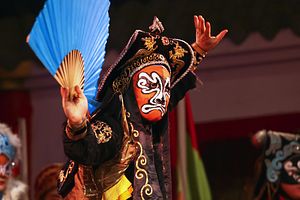Painting a paper mask on his little riverboat, Wang Bianlian is a man at the edge of defeat. His wife left him because he was too poor and his son died shortly after. To pass on the secrets of his art, he purchased a young slave boy who now sits beside him.
“Doggie,” he says to the boy, “I’m an old man. I’ll die one day.”
“Don’t die! What’ll I do if you die, Grandpa?”
“I don’t want to die,” he laughs. “But it’s not up to us. I’ve been afraid no one will carry on the family line, and that my art will die with me. Be a good boy and work hard, and I’ll give you my love… and my art.”
This scene is from Wu Tianming’s 1996 film The King of Masks, winner of the Golden Rooster for best director, which features the art of bianlian or “face-changing.” In bianlian, lavishly costumed dancers shape-shift with a mere flick of the head or sweep of the cape, swapping colorful masks with so much speed and so little movement the display is as much magic show as it is dance performance. Performers also change the color of their beards with a tug, conjure clouds with a puff of breath or, hiding gobs of greasepaint in their eyebrows and hair, transform their features with a hand wave. There’s fire-spitting, flashy acrobatics, flame balancing, cunning swordsmanship, glamorous outfits, and bafflingly intricate dance numbers too.
Dazzling though they are, these spectacles are the gimmicks of the genre, the gasp-provoking flourishes that supplement its ancient stories and songs. These less-flashy elements slowly developed over the centuries, accumulating dance routines, costumes, and stunts. By the 1600s they had coalesced into five distinct operatic styles, then later blended into one, known as chuanju or “Sichuan opera.” It’s one of China’s oldest forms of opera, yet over the ages its clandestine methods have remained a mystery.
The secret behind bianlian, for instance, is jealously guarded and passed down from one generation to the next strictly within families. This means daughters aren’t traditionally permitted to learn the art, since they marry out of the family. The cloak-and-dagger nature of the discipline also means people have scraped up acquaintances, put aside principles, spent king’s ransoms, and lied through their teeth just to get a glimpse behind the curtains. In 2003 the Hong Kong pop singer Andy Lau (Liu De Hua) allegedly paid Master Peng Denghuai $360,000 for the secrets to the art of bianlian. This became a cause célèbre that then exploded when Lau was accused (and later cleared) of leaking the secret to foreigners.
Perhaps, though, it would do some good to let the secret out. Time has not been kind to Sichuan opera. Younger generations are more immersed in other forms of media. The Yuelai Teahouse in Chengdu, long famed for its Sichuan opera productions, still manages to summon a roar of laughter or astonishment from the crowd, but the theater itself is run-down and shows neglect. Moreover, not many young Chinese men care to learn the art, and those who do are often prohibited from teaching others or performing it themselves until after the death of their master.
Like Wang Bianlian in The King of Masks, Sichuan opera masters are working hard to keep their craft alive. Maybe it’s building castles in the air to think so, but it would be lovely if they discovered a new generation of pupils and an international audience. As China comes up in the world and more of its culture goes global, this is a looming possibility. In fact, change is already in the air.
In the film, the tragic plot thickens when the old man discovers that the slave he has adopted to inherit the coveted secrets of his art is actually a girl. But these days the thought of females, foreigners, or female foreigners learning the secret Chinese art of bianlian no longer stirs the same opprobrium it once did, and some have won fame by doing it. There’s the Malaysian Chinese model Candy Chong, who reportedly learned it from her father in just two months, the Malaysian entertainer Wincci Soo, who “dabbles” in bianlian, and a Sierra Leonean named Maria who claims she is “the first black foreigner […] to do it in the world.”
This enriches the world with Chinese culture but also enriches that culture through exposure to the world, and in the process the face of bianlian is bound to change.
“I can’t dance Chinese dance in African beat,” says Maria. “I cannot do African beat and dance Chinese dance. But I’ll try to adjust them together and when you put them together it really works.”
































